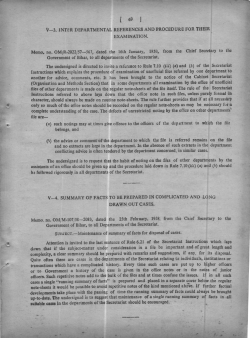
State & Local Public Health: An Overview of Regulatory Authority
State & Local Public Health: An Overview of Regulatory Authority Public health has been broadly defined as “organized community efforts aimed at the prevention of disease and the promotion of health.”1 State and local public health agencies2 are commonly described as the “backbone” of the public health system.3 Although these agencies, along with local boards of health, are all administrative bodies committed to public health, their roles in the overall governmental infrastructure can seem confusing. Not only do states and localities organize their government public health systems in many different ways, but local boards of health also vary widely in their functions, structure, level and type of regulatory authority. This publication provides common questions and answers about the role of state and local public health departments and boards of health in public health regulation.4 For information about preemption, a critical consideration when exploring the powers of these governing bodies, check out the publications and resources on the Public Health Law Center’s website here.5 Q: How is the public health system set up in the U.S.? A: The public health system in the U.S. is a complex network of people and organizations in both public and private sectors that collaborate in various ways at national, state and local levels to promote and protect public health.6 The governmental public health system is made up of public health agencies from the federal government, 51 states (including the District of Columbia), 2,794 local governments, and 565 federally recognized tribal agencies.7 Because of the broad flexibility states have in defining their public health role, the governmental public health infrastructure throughout the U.S. is extremely varied. Q: What are the main public health functions of state health departments? A: Under the U.S. Constitution, states have the power to self-govern.8 This power is generally understood to include the essential role of protecting and promoting health through populationwide actions.9 To fulfil this public health role, state health departments have a wide range of responsibilities, including the following six governance functions: Policy development: Lead and contribute to the development of policies that protect, promote and improve public health while ensuring that the agency and its components remain consistent with the laws and rules (local, state, and federal) to which it is subject. State & Local Public Health: An Overview of Regulatory Authority / 2 Resource stewardship: Assure the availability of adequate resources (legal, financial, human, technological and material) to perform essential public health services. Legal compliance: Exercise legal authority as applicable and understand the roles, responsibilities, obligations and functions of the governing body, health officer, and agency staff. Partner engagement: Build and strengthen community partnerships through education and engagement to ensure the collaboration of all relevant stakeholders in promoting and protecting the community’s health. Continuous improvement: Routinely evaluate, monitor, and set measurable outcomes for improving community health status and the public health agency’s / governing body’s own ability to meet its responsibilities. Oversight: Assume ultimate responsibility for public health performance in the community by providing necessary leadership and guidance in order to support the public health agency in achieving measurable outcomes.10 Q: How are state health departments structured? Does their structure affect the role they play in public health? A: The concept of “structure” refers to a state health department’s placement within the state government’s larger organizational infrastructure.11 In 55 percent of all states, the state health department is freestanding or independent. Some of these independent departments focus exclusively on public health, while others include such health care-related functions as the administration of Medicaid.12 In 45 percent of all states, the health department is one unit in a larger umbrella agency” (or “super-agency”)13 that includes a variety of functions, such as mental health services, public assistance, long-term care or human services, in addition to traditional public health functions.14 State health departments serve multiple public health functions, some of which are shared or assumed by sister agencies in state government (e.g., licensure of health professionals, the regulation of indoor air quality, or the regulation and inspection of health care facilities). Despite a wide range of governance structures, each state’s health department is generally the primary public health authority within the state and plays a key role in supporting the delivery of public health services. Approximately 60 percent of all state public health departments are governed by a board or council of health. According to a 2012 study, these boards and councils most often promulgate rules (65.4%); advise elected officials on public health policies and concerns (50%); develop state public health policies (38.5%); and develop legislative public health agendas (32.1%).15 Members of these boards and councils are often gubernatorial appointees and may be public health professionals, citizens, consumers, business professionals, and educators. Legislatures approve the state public health agency budget, pass public health laws and regulations, determine fees for health services, and establish taxes in support of public health.16 Thus, state public health agencies tend to be strongly influenced by their elected officials. State & Local Public Health: An Overview of Regulatory Authority / 3 Q: How are local health departments structured and where do they get their regulatory authority? A: Local health departments are structured in a variety of ways, but they all derive their authority from the state.17 Their roles, responsibilities, and scope of public health authority depend largely on state policy and the governing relationship between state and local health departments.18 Below are the most common governance structures: Centralized/state: All the local health departments are units of state government. Local or decentralized: Local health departments are led by local governments which make most fiscal decisions. Mixed/hybrid system: Some local health departments are led by state government and some by local government. Shared system: All local health departments are governed by both state and local authorities.19 States typically have at least two levels of local governments: counties and municipalities (which can include cities, townships, towns, boroughs, villages and hamlets). The role and regulatory structure of local health departments can vary as widely as the types and sizes of jurisdictions served. For example, local health departments in large metropolitan areas may have a broad range of functional capacities similar to, and in some cases more developed than, those of state health departments.20 On the other hand, small local health departments often provide a narrow set of public health services. Local health departments can be structured as a “locally governed health department, a branch of the state health department, a state-created district or region, a department governed by and serving a multi-county area, or any other arrangement that has governmental authority and is responsible for public health functions at the local level.”21 In addition, the public health community in each jurisdiction includes individuals and public and private entities engaged in activities that affect the public’s health.22 Q: Do state and local departments provide similar public health services? A: Both state and local health departments serve critical roles in promoting and protecting the health of residents in their jurisdictions. State health departments provide many population-based public health services related to primary prevention, screening and treatment of diseases and conditions. Duties of a state health department often include (1) disease surveillance, epidemiology, and data collection; (2) state laboratory services; (3) preparedness and response to public health emergencies; (4) population-based primary prevention; (5) health care services; (6) regulation of health care providers and other licensed professions; (7) environmental health; and (8) technical assistance and training.23 According to a recent study, their most common prevention services include tobacco (87%), HIV/AIDS (85%), sexually transmitted disease counseling and partner notification (85%), nutrition (79%), and physical activity (77%).24 In addition, more than 90 percent of all state health departments perform vaccine order management and inventory distribution for childhood immunizations, and over 80 percent for adult immunizations.25 The different governance structures of local health departments affect their capacity, regulatory authority, resources, composition, and the public health services they provide.26 Despite these differences, local health departments generally have a responsibility to State & Local Public Health: An Overview of Regulatory Authority / 4 coordinate public health activities in their jurisdiction. The following standards, developed by the National Association of County & City Health Officials, illustrate public health services a typical local health department provides: 1. Monitor health status and understand health issues facing the community. 2. Protect people from health problems and health hazards. 3. Give people information they need to make healthy choices. 4. Engage the community to identify and solve health problems. 5. Develop public health policies and plans. 6. Enforce public health laws and regulations. 7. Help people receive health services. 8. Maintain a competent public health workforce. 9. Evaluate and improve programs and interventions. 10. Contribute to and apply the evidence base of public health.27 Q: What are local boards of health and what regulatory powers do they have? A: Local boards of health are administrative bodies whose members are appointed or elected to lead, guide, and oversee the delivery of public health services and activities in their communities.28 According to the Centers for Disease Control and Prevention, the top ten responsibilities of local boards of health are: 1. Review public health regulations. 2. Recommend public health policies; 3. Recommend community public health priorities; 4. Recommend health department priorities; 5. Propose public health regulations; 6. Collaborate with health departments for strategic plans; 7. Collaborate with health departments to establish priorities; 8. Ensure that a community health assessment is completed; 9. Revise public health regulations; and 10. Establish community public health priorities.29 Local boards of health are also often in charge of clinical prevention strategies such as immunizations. The role, legal authority and regulatory powers of local boards of health vary by jurisdiction. For example, some boards enact rules and regulations, while others advise or make recommendations to the local governing body for public health, such as a city council, county board of commissioners, or tribal board. All boards, regardless of the extent of their legal authority, are obligated to enact or recommend policies that serve the public’s health.30 Q: What is Dillon’s Rule and how does it affect whether or not a local government has authority to regulate public health? A: Although in a general sense, states exercise complete authority over local governments, relationships between states and localities vary widely. State statutes and state constitutions specify the powers of local governments. In instances where it is unclear whether a state has explicitly granted a certain power to a local government, most states follow a tenet of municipal law called Dillon's Rule.31 Under this traditional rule, local governments only have powers that State & Local Public Health: An Overview of Regulatory Authority / 5 state law explicitly delegates to them, such as the power to pass laws or regulate in certain areas. Dillon’s Rule is what is called a “narrow interpretation” of local authority. 32 Under Dillon’s Rule, for instance, a municipality may be prohibited from implementing certain public health policies. Q: What impact does home rule have on a local government’s ability to regulate public health? A: Many states grant local governments the general power to manage their own affairs, which gives them more governing authority than assumed under Dillon’s Rule. This “home rule” system is established through the state constitution or state statutes, and gives cities and counties the authority to set up their own system of self-government.33 Municipal home rule (sometimes exercised through a local home rule charter) essentially transfers certain law and policymaking authority from the state legislature to the local governments. Under home rule, local officials exercise greater autonomy in governing localities and generally have more flexibility and authority to adopt and implement public health policies than under Dillon’s Rule. Other Helpful Resources The Public Health Law Center features on its website several resources on the role of state and local preemption in public health. For information on the public health role of each state’s health department, see the U.S. Centers for Disease Control & Prevention’s Public Health Resources: State or Territorial Health Departments. The National League of Cities’ online resource, Cities 101, provides useful information about U.S. municipal governments, including their structures, powers, and composition. Other organizations with helpful information on their websites about state and local public health authorities include the Association of State and Territorial Health Officials (http://www.astho.org), the National Association of County and City Health Officials (http://naccho.org), and the National Association of Local Boards of Health (http://nalboh.org). Contact Us Please feel free to contact the Public Health Law Center at publichealthlawcenter@wmitchell.edu with any questions about the information in this publication. Last updated: April 2015 State & Local Public Health: An Overview of Regulatory Authority / 6 Notes 1 INSTITUTE OF MEDICINE, THE FUTURE OF PUBLIC HEALTH (1988), available at http://www.nap.edu/openbook.php?record_id=1091&page=R. The term “agency” is used here to cover departments, divisions, and similar designated authorities. 2 3 Eileen Salinsky, Governmental Public Health: An Overview of State and Local Public Health Agencies National Health Policy Forum Background Paper No. 77 8 (2010), available at http://www.nhpf.org/library/background-papers/BP77_GovPublicHealth_08-18-2010.pdf . Although we do not discuss tribal public health agencies in this publication, tribal agencies play a key role in the U.S. public health system. 4 The information contained in this document is not intended to constitute or replace legal advice. The website contains a series of publications on public health and preemption, including preemption’s impact in specific areas, such as tobacco control. See, e.g., Tobacco Control Legal Consortium, Preemption: The Biggest Challenge to Tobacco Control, available at http://publichealthlawcenter.org/sites/default/files/resources/tclc-fs-preemption-tobacco-controlchallenge-2014.pdf. 5 6 See Justeen K. Hyde & Stephen M. Shortell, The Structure and Organization of Local and State Public Health Agencies in the U.S.: A Systematic Review, AM. J. PREVENTIVE MEDICINE (2012), available at http://www.rwjf.org/content/dam/farm/articles/journal_articles/2012/rwjf72639. 7 Id. at S31. 8 U.S. CONST. amend X. Medtronic, Inc. v. Lohr, 518 U.S. 470, 475 (1996); Nat’l Ass’n of Tobacco Outlets, Inc. v. City of Providence, R.I., 731 F. 3d 71, 79 (1st Cir. 2013). 9 Nat’l Ass’n of Local Boards of Health et al., The Governance Functions (2012), available at http://www.nalboh.org/?page=GovernanceResources. 10 11 Salinsky, supra note 4, at 8. As of 2012, 48 state public health departments reported having a total of 2,744 local health departments and 298 regional or district offices. In addition, 22 state health agencies (45%) report having a state board of health, while four states (8%) report having an entity that performs similar functions. 12 Id. Ass’n of State and Territorial Health Officials, State Health Agency Structure and Governance, Issue Brief (last accessed April 2, 2015), available at http://www.astho.org/Profile/Volume-Three/IssueBriefs/Structure-and-Governance. 13 14 Salinsky, supra note 4, at 8. Hyde & Shortell, supra note 6, at S32-3. “The governor in most states (68%) has authority to hire or appoint the State Health Official, who is responsible for the day-to-day activities of the agency, policy setting, and keeping the legislature informed of public health matters, among many other activities.” Id. at S33. 15 16 Id. 17 McMillan v. Monroe County, Ala., 520 U.S. 781, 780 (1997), available at https://supreme.justia.com/cases/federal/us/520/781/case.html. See Ass’n of State and Territorial Health Officials, State Public Health Agency: Understanding the Relationship between State and Local Public Health (2012), available at http://www.norc.org/PDFs/Projects/Classification%20of%20State%20Health%20Agencies/ASTHO%20 18 State & Local Public Health: An Overview of Regulatory Authority / 7 NORC%20Governance%20Classification%20Report.pdf (explaining how governance structure varies in each state). 19 Ctrs. for Centers for Disease Control and Prevention, United States Public Health 101 (2013), available at http://www.cdc.gov/stltpublichealth/docs/usph101.pdf. 20 Salinksy, supra note 4, at 15. Nat’l Ass’n of County & City Health Officials, Operational Definition of a Functional Local Health Department 9 (2005), available at http://www.naccho.org/topics/infrastructure/accreditation/OpDef.cfm. 21 22 Id. at 2. 23 Id.; Ctrs. for Centers for Disease Control and Prevention, supra note 19. Ass’n of State and Territorial Health Officials, ASTHO Profile of State Public Health, Vol. 3, 43 (2014), available at http://www.astho.org/Profile. 24 25 Id. at 45. 26 See Nat’l Ass’n of County & City Health Officials, supra note 21. 27 Id. 28 See Tobacco Control Legal Consortium, Local Board of Health Authority for Tobacco Control (2014), available at http://www.publichealthlawcenter.org/sites/default/files/resources/tclc-fs-boh-authoritytobacco-control-2014_0.pdf. 29 30 Ctrs. for Disease Control and Prevention, supra note 19. Id. Nat’l League of Cities, Local Government Authority (2013), available at http://www.nlc.org/buildskills-and-networks/resources/cities-101/city-powers/local-government-authority. 31 Nat’l Ass’n of Counties, Dillon’s Rule or Not? (2004), available at http://celdf.org/downloads/Home%20Rule%20State%20or%20Dillons%20Rule%20State.pdf. Today, thirty-nine states employ Dillon’s Rule to all local governments and eight states employ the rule to some local governments. (For instance, Alabama’s enforcement of Dillon’s Rule only applies to county governments, while California’s enforcement excludes charter cities.) Id. 32 33 See Jesse Richardson, Jr. et al., Is Home Rule The Answer? Clarifying The Influence of Dillon's Rule On Growth Management, Brookings Institute (2003), available at http://www.brookings.edu/~/media/research/files/reports/2003/1/01metropolitanpolicyrichardson/dillonsrule.pdf.
© Copyright 2025









